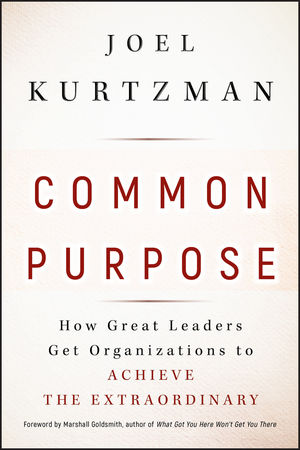Common Purpose: How Great Leaders Get Organizations to Achieve the ExtraordinaryISBN: 978-0-470-49009-9
Hardcover
240 pages
March 2010, Jossey-Bass
 This is a Print-on-Demand title. It will be printed specifically to fill your order. Please allow an additional 10-15 days delivery time. The book is not returnable.
|
||||||
Connect with Wiley Publicity
In our current economic situation we look to leadership for answers and solutions. This is especially true in the world of business and commerce. How are some businesses able to flourish, we wonder, while so many others are hopelessly failing? And what leadership qualities will companies need to succeed coming out of this recession? In COMMON PURPOSE: How Great Leaders Get Organizations to Achieve the Extraordinary (Jossey-Bass; March 2010; $27.95; Hardcover), Joel Kurtzman argues that the creation of common purpose, a new concept, is the essence of leadership. In framing his cogent explanation, the author draws upon two decades of research, hundreds of interviews, personal observation, and interactions with countless leaders.
Common purpose occurs when a leader is able to get a group to internalize an organizations’ values, tools, objectives, and aspirations enabling them to work toward one goal. In Kurtzman’s framework, an effective leader does not separate himself from the group that he leads. Instead, he acts as the glue that holds the organization together. Common purpose enables a leader to impel others to act without directing their every move. It encourages autonomous actions around common goals.
Common purpose is what turns me into we.
Kurtzman explains many different ways in which a common purpose creates performance. Using well-known, as well as personal examples, Kurtzman advises ways to achieve this goal. These are just a few examples:
- Emphasize One Goal – Gordon Bethune, CEO of Continental Airlines, recognized that his customers valued on-time performance. He set this as the measure of success for the company. In order to underscore this goal, Bethune decided to send every employee a check every time the company was first in on-time arrival. In the different cities, pilots, flight attendants, agents, mechanics, baggage handlers, and everyone else united together to achieve this one goal, while reinforcing the feeling of “one team”.
- Become Flat, Instead of Hierarchical – In a hierarchical organization information supplied by subordinates is looked at with condescension by individuals at the top. In the case of Enron, Sherron Watkins signaled to Ken Lay, the chairman of the organization, that something was wrong with the company’s partnerships and the way they were kept off the books. Lay ignored the information due to the rationalization that if something was wrong, he, as chairman, would know. Creating different levels of importance in an organization usually works against common purpose.
- Leaders at All Levels – When a company has a common purpose, all employees have an understanding of what the organization stands for, enabling them to make a decision independently based on that information. Simon Cooper, president and CEO of Ritz-Carlton, calls this “scriptless service”. With such a diverse clientele, employees cannot simply operate by choosing from a limited number of preselected solutions to guest requests. A chambermaid must be empowered to decide on her own volition whether to give a guest extra towels based upon what was used the night before.
- Lead by Listening – FM Global’s chairman and CEO, Shivan Subramaniam, takes every opportunity to listen to his employees. He eats in the company’s cafeteria and often sits with random groups of FM Global employees. Subramaniam puts himself in the loop of what is going on with the company. It also makes him accessible to his employees, in case they wish to share their ideas.
The goal of an organization is to achieve maximum performance consistently. As Kurtzman so deftly explains without a strong common purpose, there will be no excellence in execution.



